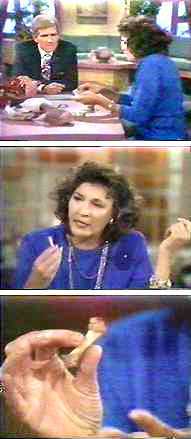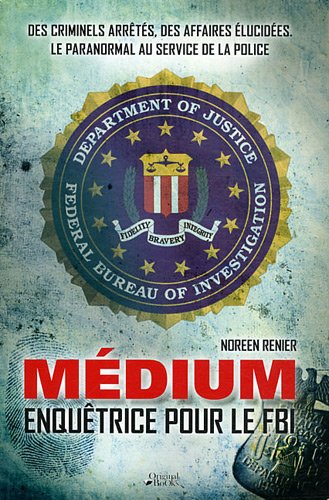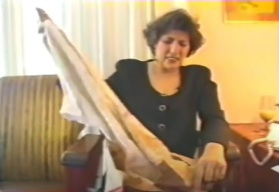
|
From Psychic Sleuths:
ESP and Sensational Cases Edited by Joe Nickell Prometheus Books (1994) (Pages 60-85) |

|

|
From Psychic Sleuths:
ESP and Sensational Cases Edited by Joe Nickell Prometheus Books (1994) (Pages 60-85) |

|
|
|
Since I admit to a lack of ESP, I cannot read Renier's mind to divine why she has chosen to move on. But on the May 22, 1990, "Joan Rivers Show" she said, "I don't do presidents any more because I had so many people on me when I did the Reagan one that I just decided that I wasn't going to do presidents any more. I get too much attention." Renier is now strictly a "homicide detective." Her fee: about $400 per case.14
When asked by Rivers about how she first discovered her psychic
power, Renier explained that she "used to be a skeptic.
Renier told Rivers that "The police have to invite me in on a case." Law enforcement agencies hear of her, she said, by "word of mouth" from other police agencies who "are proud of what I do, and they tell another agency.
Others say they have used psychics with excellent results. They say psychics can help bring an
unsolved crime to a successful conclusion. They say they would use a psychic again.
As a professional psychic with extensive experience in police work, backed up by recommendations from the FBI, I offer your Training Center a bold new understanding about psychics and their work with law enforcement officers.15
Although one might infer an eagerness to travel the country to lecture to police agencies, Renier told Joan Rivers that she has grown "tired of going all around the country to police stations and scenes of crime," preferring instead to conduct her homicide investigations in the comfort of her own home. The police, Renier says, "just send me objects off the body," such as a bullet or a piece of clothing, for her to "tune in" on. By so doing, she is able to relive the crime (e.g. while holding a bloody shirt, she
in effect becomes the murder victim, experiencing agony as the bullets impact), and is able to visualize the murderer as if through the victim's eyes. Recounts Renier, "I have had my throat slit, I have been stabbed, I've been a man and shotgunned down here (pointing to her lower abdomen). I can actually feel it for a few moments."
Then, says Renier, "I have a police artist that works with me, and he draws the face, and we send the face to whatever department we are working with. And then they're real happy, usually."
A potential source of unhappiness for the police is adroightly handled by this sensitive seer. As she told Rivers, "I try not to tune in to X-rated stuff. The police are always worried that I'm going to see things about their sexual life or about who they went out with last night, or who they're cheating on. So I tell them, 'No X-rated stuff - I don't do that.'"
Renier also displayed "a piece of a bone they sent me
Another guest on that day's program was Dr. Eugenie Scott, Executive Director of the Berkeley, California-based National Center for Science Education, with whom I discussed the show when I met her at a conference in May 1991. During a commercial break, Scott had mentioned to Collins that Renier's parading of such items across the country would be a gross violation of police procedure since, once allowed out of their custody, such "evidence" would no longer be admissible in court. When Collins again chatted with Renier during the show's final segment, he asked her if law enforcement agencies really "let that evidence go around the country, police evidence, the kind of stuff that you brought today." An apparently flustered Renier stammered in response, "Uh, no, I don't think so, really. I,I,I,I, they don't know I have it here. And I haven't worked on it either." Responded Collins, looking directly into the camera, "
As alluded to in Collins' remarks that introduce this chapter, Renier's promotional "bio" said that her law enforcement cases have included "several for the Federal Bureau of Investigation." It added that "Mrs. Renier will not accept a case unless an officially authorized representative of the agency having jurisdiction contacts her directly. At that time an agreement
outlining fees, expenses, and confidentiality requirements will be sent."16
During a July 16, 1990, return engagement on the "Joan Rivers Show," which emanates from New York, Renier participated in a panel discussion of that city's fearsome "Zodiac" killer (along with New York Post reporter Anne Murray, and criminology professor Candice Skrapec). At one point, Renier was handed photocopies of two letters that "Zodiac" had sent to authorities, with the hope that she would be able to perform a "psychometry" reading and assist in the identification and capture of this dangerous criminal.
After first apologizing for what she feared might be inaccurate
information because she was not working with evidence "off the body," within seconds Renier began speaking in the first person, as if she had become "Zodiac," saying such things as "My beard is now shaved," "I feel like maybe Spanish is very prominent in me," and "I don't know if they called me 'stupido' or what when I was younger." She then adopted a hostile expression and tone of voice, and said, "I'm killing because these men are worthless anyway, so it doesn't matter if they're dead, I don't care if they're dead, no one else cares if they're dead. I'm just killing people
that no one cares [about] anyways. I have two more before I'm caught." She then emerged from first person and added, "I don't know if he'll kill them both, but I feel two more attempts -- maybe one will be killed."
When asked by an enthralled Rivers, "Where does he live?," Renier
began gesticulating in all directions, eyes closed, describing how "I felt a river there, and I felt a very dark brick building
Unfortunately for the terrorized citizenry of New York City, Renier was apparently unable to specify the stretch of river, the bridge, the apartment building, the traffic light/intersection, or the identity of the "younger man." Even more regrettable was her apparent inability, when she "became" the killer, to discern her own name!
Following this performance, Rivers asked, "Would you give this
information to the police, or would the police come and ask you for it?" Renier responded by saying, "I'm sure if I asked them and told them about me, they would, I'm sure. And there's a possibility we'll do some contacting with them after the show." Rivers then reluctantly read a disclaimer on behalf of the show (which she said she found "embarrassing" to have to do) to the effect that Renier's information "is only theory," and that if "police investigation in the capture of this criminal" should confirm its accuracy, "we'll have you back." (She has been back anyway.)
On the following day's show, Rivers proudly announced that as a result of that appearance, Renier was now working with the New York Police
Department on the "Zodiac" case. However, when I called NYPD in an effort to confirm this claim, I was informed by Officer St. Just of the
NYPD Public Information Office that Renier was "not working with the Police Department" on the case. Although, he said, as a matter of policy
he could/would not exclude the possibility that Renier might have called or visited NYPD to offer information as might any other citizen,
"We didn't reach out [for her]."20 [Note: As narrated in the introduction to the 12/3/2003
episode of Forensic Files titled "Sign of the Zodiac"
(which contains no mention of Renier or any other "psychic"), "It took forensic astronomy, handwriting analysis, and a World War II codebreaker
to find him."]
But faced with a 1½-year-old unsolved murder case of their own and an ice-cold trail, south Florida detectives Ralph Pauldine and Henry Mackey definitely did reach out for Renier, as the nation learned during the May 13, 1992, telecast of CBS-TV's weekly newsmagazine "48 Hours" in
a segment titled "Hard Evidence." With CBS video crews taping simultaneously at the detectives' office and at Renier's home (the two locales were also connected by speakerphones), reporter Doug Tunnell explains how "just for starters, [Renier] transports herself back to the crime scene and enters the victim's body." She then accurately describes the murder scene (a portly, shirtless, middle-aged man, mortally wounded in the neck). The police, Tunnell reports, are convinced that she had no advance knowledge of the case. But given the elaborate choreography required to put this TV spectacle together, a skeptic might suspect that a person with police contacts (such as a professional "psychic detective"), or perhaps even a national television news department, could have made prior inquiries about the nature of the case to be televised.
To further bolster the credibility of Renier and of his uncritical
journalistic effort, Tunnell also interviewed Ray Krolak about the upstate New York murder case discussed earlier in this chapter. Says Tunnell, "One of the people Noreen led police to was a new suspect.
If Renier's Reagan/Sadat predictions are indicative of a remarkably keen "psychic" ability to foresee such earth-shaking events, one might hope that she would make it a practice to provide her sage counsel to the world's leaders. If, on the other hand, after having struck out with Carter/Mondale, Renier simply lucked out with Reagan/Sadat, one might perhaps anticipate a retreat from the presidential death watch, so as not to risk further lowering her batting average with another series of misses.
 Yet, her promotional packet, as noted earlier, contains letters of recommendation ideal for use in solicitation. Renier mailed one such
packet in October of 1989 to "Director Richard N. Harris, Department of Criminal Justice Services" in Richmond, Va. The packet appears to
have then been forwarded to a skeptical organization, along with Renier's accompanying cover letter
which begins:
Yet, her promotional packet, as noted earlier, contains letters of recommendation ideal for use in solicitation. Renier mailed one such
packet in October of 1989 to "Director Richard N. Harris, Department of Criminal Justice Services" in Richmond, Va. The packet appears to
have then been forwarded to a skeptical organization, along with Renier's accompanying cover letter
which begins:
Some say ESP and Psychic Phenomena does (sic) not exist. Some say the police who have used psychics
had negative results. They say all psychics are frauds.
 Nevertheless, PG-rated demonstrations of her "psychic" skills have
dazzled national television audiences. For example, for her November 7, 1988, performance on "Hour Magazine," Renier brought along a collection of what she described as police evidence from "current cases," including a belt and bloody shirt allegedly from a shooting victim. Renier closed her eyes, held the belt in her hand, and began to describe the circumstances of the murder as if she herself were the victim. She claimed to feel the impact of the bullets in her neck and elsewhere, and after a few moments asked host Gary Collins if she could stop, since "I get a little upset."
Nevertheless, PG-rated demonstrations of her "psychic" skills have
dazzled national television audiences. For example, for her November 7, 1988, performance on "Hour Magazine," Renier brought along a collection of what she described as police evidence from "current cases," including a belt and bloody shirt allegedly from a shooting victim. Renier closed her eyes, held the belt in her hand, and began to describe the circumstances of the murder as if she herself were the victim. She claimed to feel the impact of the bullets in her neck and elsewhere, and after a few moments asked host Gary Collins if she could stop, since "I get a little upset."
 However, Robert Ressler testified in his deposition that Renier's claim to having worked as a psychic for the FBI "is not true from the standpoint of being a paid employee and is not true from the standpoint of her being on a retainer or being used in any regular capacity. She does not work on FBI cases."17 Added Ressler, "Merrell wanted to know whether the FBI used psychics in our investigative process. And I told him that was absolutely something I wouldn't discuss, but, in reality, we don't."18
Additionally, Renier was compelled to modify her promotional literature as a result of a reproach by Ressler, who testified that she had claimed "that she was an instructor for the FBI, something along that line, and I told her she could not say that."19
[Late note: Though not the case with the English printings of her two-decade-later memoir, A Mind for Murder, its French edition (see right) nevertheless features the FBI emblem on the cover and a title that translates to Psychic Investigator for the FBI.]
However, Robert Ressler testified in his deposition that Renier's claim to having worked as a psychic for the FBI "is not true from the standpoint of being a paid employee and is not true from the standpoint of her being on a retainer or being used in any regular capacity. She does not work on FBI cases."17 Added Ressler, "Merrell wanted to know whether the FBI used psychics in our investigative process. And I told him that was absolutely something I wouldn't discuss, but, in reality, we don't."18
Additionally, Renier was compelled to modify her promotional literature as a result of a reproach by Ressler, who testified that she had claimed "that she was an instructor for the FBI, something along that line, and I told her she could not say that."19
[Late note: Though not the case with the English printings of her two-decade-later memoir, A Mind for Murder, its French edition (see right) nevertheless features the FBI emblem on the cover and a title that translates to Psychic Investigator for the FBI.]
 Renier then opens a package of evidence (a bloody towel [right -- click image to watch the show] and a beer
can believed to have been handled by the killer). Says Tunnell, "Noreen now enters the body of the killer
Renier then opens a package of evidence (a bloody towel [right -- click image to watch the show] and a beer
can believed to have been handled by the killer). Says Tunnell, "Noreen now enters the body of the killer
|
|
|
|
Return to Posner's Home Page
Return to Posner's Publications Page
Return to list of Articles on Noreen Renier